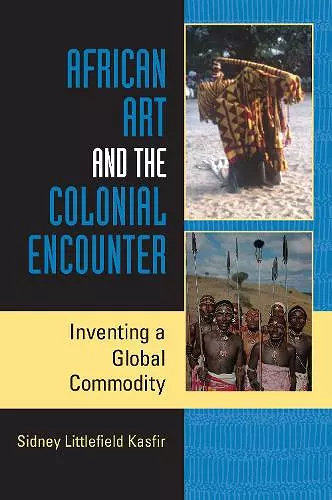African Art and the Colonial Encounter
Inventing a Global Commodity
Sidney Littlefield Kasfir author
Format:Paperback
Publisher:Indiana University Press
Published:24th Oct '07
Currently unavailable, and unfortunately no date known when it will be back

Explores African art and artistic production in a volatile global marketplace
Focusing on the theme of warriorhood, Sidney Littlefield Kasfir weaves a complex history of how colonial influence forever changed artistic practice, objects, and their meaning. Looking at two widely diverse cultures, the Idoma in Nigeria and the Samburu in Kenya, Kasfir makes a bold statement about the links between colonialism, the Europeans' image of Africans, Africans' changing self representation, and the impact of global trade on cultural artifacts and the making of art. This intriguing history of the interaction between peoples, aesthetics, morals, artistic objects and practices, and the global trade in African art challenges current ideas about artistic production and representation.
To help alter and broaden the meaning that some of her western professional colleagues associate with African objects, art historian and curator Kasfir (Emory Univ.) applies and draws lessons from certain anthropological practice from the 1980s and literary theory from the 1990s to two examples of African artifacts. "Sustained fieldwork" undergirds her study of the spears of the pastoralist Samburu of the Rift Valley, in Kenya, East Africa, and of the masks of the agricultural Idoma in Nigeria, West Africa. The comparison of these two quite different tribes and their artifacts unfolds in four parts: warriors and warriorhood, "artists" and their products, "the objects themselves," and commodification and globalization. Practicing anthropologically, Kasfir digs into the cultural fabric of the tribes and applies it to their artifacts. She recognizes the different impacts of varied British colonial policy upon the tribes and records some of the misreadings of tribal culture by European explorers, colonial officials, and settlers. As historian, she underlines cultural change and the consequent meaning of embedded artifacts over time—something that western artists and curators (let alone tourists) do not always apply to their reading of African objects. A provocative and useful addition to postcolonial analysis. Summing Up: Highly recommended. Faculty and specialists. —Choice
-- J. L. Cooper * Choice *Over the course of the past thirty years, Sidney Kasfir has become known as one of the most critical and conceptual minds in African art history. . . Sidney Kasfir, one of the freshest minds of African art history . . . .March 2010
* The Journal of African History *. . . persuasively demonstrates the degree to which colonialism reshaped artistic production and meaning, and also how artists were agents of resistance through creative transformation.Vol. 52.2 Sept. 2009
-- Mary Nooter Roberts * University of California, Los Angeles *Kasfir provides a robust historical account bridging the study of "classic" African art markets—precolonial objects—with contemporary art markets, which still exoticize African artworks.Vol. 43.1, 2010
* International Journal of African Historical Studies *. . . there is little doubt that [this book] . . . will be compulsory reading for critical African art history syllabi for years to come. . . This book takes history very seriously, and in doing so, it brings a properly researched post-colonial critical discourse to bear on histories - those of the Samburu, the Idoma and African art history itself. In doing so it shows how art (artefact, material culture, objects . . . whatever) can both make those histories and be a vital part in our understanding of how the world is represented.#70 Dec. 2008
-- Will Rea * University of Leeds *. . . it is highly recommended with its emphasis on the three Cs—colonialism, commodity, and complexity of representation.September 2009
-- Joseph Nevadomsky * H-AfrArts *A provocative and useful addition to postcolonial analysis. Summing Up: Highly recommended. Faculty and specialists.January 2009
* Choice *. . . well organized, analytically rich, elegantly written and a compelling read.Vol. 40.3 August 2009
-- Mary Jo Arnoldi * Smithsonian InstitutiISBN: 9780253219220
Dimensions: unknown
Weight: 699g
408 pages